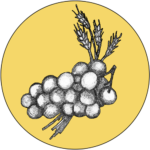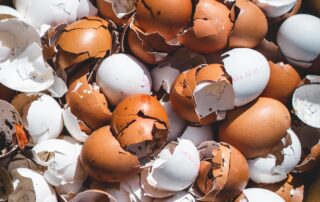 Pillar: Sacramental Ecology
Pillar: Sacramental Ecology
Laudato Si’ Action Plan Goal: Ecological Education
 Pillar: Sacramental Ecology
Pillar: Sacramental Ecology
Laudato Si’ Action Plan Goal: Ecological Education
Group (Grade Levels): 1-5
Learning Goals:
- raise awareness of the relationship between soil nutrients and plants by observing how plants with compost soil flourish as opposed to plants in sand.
- draw forth analogies between soil nutrients and graces from God.
Materials Needed:
- 6 planting pots (3-4 inches each is a good size)
- Sand (enough to fill 3 planting pots)
- Potting soil and some fully cooked compost (enough to fill the other three planting pots)
- 12 Lima beans, to plant two in each of the pots
- Chart of what nutrients are found in soil, what each of these nutrients does for the plant, and compostable items that contain these nutrients
| Nitrogen | Potassium | Phosphorus | Carbon |
|---|---|---|---|
| This nutrient helps the plant make chlorophyll and carry out the photosynthesis process. | This nutrient helps the plant absorb the water in the soil and use it in an efficient way. | This nutrient helps the plant form new growth and it is especially helpful for root growth and allowing the plant to reach maturity (which often means more nutrient-rich food harvested from the plant). | This nutrient helps the cooking balance in the compost; if the compost smells too strongly of ammonia, add more of these types of items |
| Grass clippings | Banana peels | Manure | Autumn leaves |
| Coffee grounds | Citrus rinds | Egg shells | Wood chips |
| Fruit and vegetable scraps | Spinach | Fish | Sawdust |
| Bread | Tomatoes | Shredded paper | |
| Compostable paper plates and napkins |
Pre-planning: Gather experiment materials ahead of time; during time of experimentation, observe plants and the participants’ written observation of the plants to be prepared for the moment of discussion when they arrive at their discovery of the role of soil nutrients
Beyond the initial set-up, the participants (a group of 3-4) should be able to carry out this experiment independently until it is time to introduce the role of soil nutrients.
Estimated Time to Complete Activity: Experiment set-up will take about 1 hour.
Estimated Number of Sessions if Activity Continues: Ongoing observations of plants should be made for at least 6-8 weeks; after participants begin to notice difference in health of the plants in soil versus the plants in sand, the follow-up conversation with soil nutrients chart may be facilitated
General Outline of Experience
- Scripture passage and suggested introductory questions; Psalm 104:1-2, 15:
“Bless the Lord, my soul!
Lord, my God, you are great indeed!
You are clothed with majesty and splendor,
robed in light as with a cloak.
You make the grass grow for the cattle
and plants for people’s work
to bring forth food from the earth,
wine to gladden their hearts,
oil to make their faces shine,
and bread to sustain the human heart.” - Invite the children to reflect on ways they see God providing for our needs, the needs of the animals he created, and the needs of the plants he created.
- After a period of time, invite the children to share their reflections aloud.
- Close with a prayer.
- Orientation to tools/elemental techniques: introduction to experimental materials, how seeds will be planted at the same depth in pots according to the directions on the seed packet.
- Demonstration of how to use tools: watering, but not over-watering; placement of planting pots in warmth and sunlight; discussion of how observations will be made and recorded.
- Guide participants to set up an experiment to discover the nutrient needs of plants. In 3 planting pots, plant 2 lima beans each in sand. In another 3 planting pots, plant 2 lima beans each in soil that has a small amount (no more than a tablespoon) of fully cooked compost mixed thoroughly into the soil. The seeds will need regular watering, warmth and sunlight.
- The children will record observations of the plant growth and plant health over a period of 6-8 weeks.
- Follow-up work after the discovery of soil nutrients will lead to the participants’ implementation of a class compost.
- Older elementary children may enjoy further research of types of compost and discussion about which compost type best meets the needs of the classroom.
Proposed discussion questions for during the activity; and/or auxiliary activities
- After the children have discovered the difference in health between plants grown in soil containing a small amount of compost and plants growth without the nutrients provided by compost, discuss the roles of nitrogen, potassium and phosphorus in the plant’s growth and how each of these nutrients can be added to soil by compost. Discuss which compostable items contain each of these items.
- Invite the children to discuss how they would like to begin composting in the classroom or at home, and how they would like to introduce the compost plan to their classmates or families. Discuss the supplies needed to have a compost bin in the classroom, to make a compost structure outdoors at the school, the responsibilities of taking the classroom compost out and turning the compost pile. The children may also want to make posters about what can or cannot be composted in the classroom compost bin.
- After the compost pile is well-established, the children may want to plan the use of their compost, such as in a class garden.
- Proposed discussion questions
- After the children have arrived at their discovery of the role of soil nutrients, re-read Psalm 104:1-30 and discuss how soil nutrients are one way God cares for the needs of all of his creation, how every detail is thought of in his wonderful gift of creation.
- Potential analogies
- Children may also discuss other ways God cares for every detail of our needs, and how these details are connected to each other.
- Discuss with participants the specific ways God provides for our needs by giving us grace: his own love within us.
- He does this through other people, the sacraments, creation, and sometimes directly.
- Which grace in our lives is like nitrogen? Potassium? Phosphorus? Carbon? Encourage participants to think about the specific roles of these nutrients and how they are also given spiritually.
Cross-references to related experiential activities: Compost experience – Maintaining a compost pile




